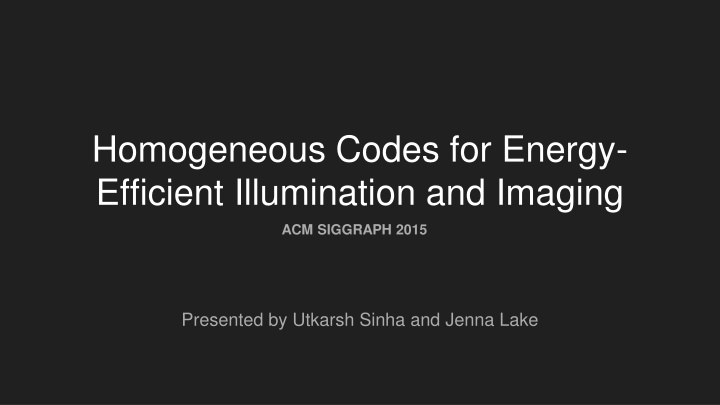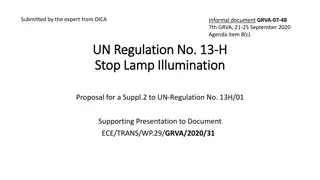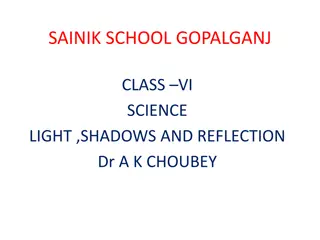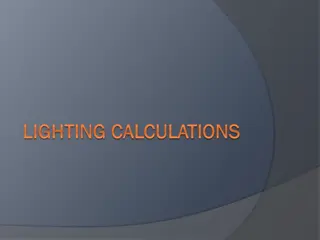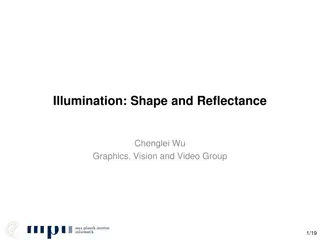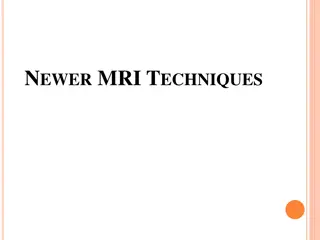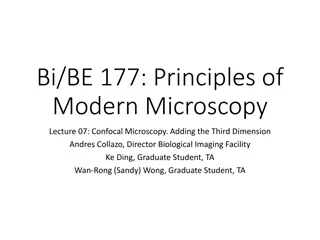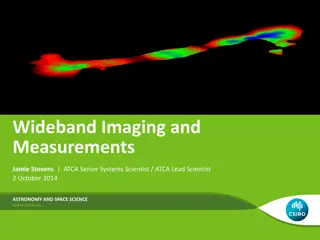Energy-Efficient Illumination and Imaging Techniques for Structured Light Applications
This presentation at ACM SIGGRAPH 2015 by Utkarsh Sinha and Jenna Lake explores the use of homogeneous codes to optimize energy efficiency in structured light applications. The focus is on distinguishing between translucency and inter-reflections, removing artifacts, reconstructing 3D objects in challenging conditions, capturing structured light video of bright scenes, and more. Challenges include inefficient masks, the need for short exposures in live imaging, and the potential for unwanted artifacts. Various devices and techniques like VSYNC chips, rolling shutter cameras, and illumination patterns are discussed for efficient photon capture in imaging. The concept of energy efficiency is also detailed, considering factors like total time, energy generated by projectors, and the redistribution factor.
Download Presentation

Please find below an Image/Link to download the presentation.
The content on the website is provided AS IS for your information and personal use only. It may not be sold, licensed, or shared on other websites without obtaining consent from the author.If you encounter any issues during the download, it is possible that the publisher has removed the file from their server.
You are allowed to download the files provided on this website for personal or commercial use, subject to the condition that they are used lawfully. All files are the property of their respective owners.
The content on the website is provided AS IS for your information and personal use only. It may not be sold, licensed, or shared on other websites without obtaining consent from the author.
E N D
Presentation Transcript
Homogeneous Codes for Energy- Efficient Illumination and Imaging ACM SIGGRAPH 2015 Presented by Utkarsh Sinha and Jenna Lake
Motivation Goal How can we use energy most effectively in structured light applications? Applications Distinguish between translucency and inter-reflections Remove artifacts caused by structured light Reconstruct 3D objects in challenging conditions (smoke, strong lights) Record live video from the projector s point of view Capture structured light video of very bright scenes
Challenges Masks are inefficient (blocked photons are wasted) Required for light-field displays and indirect-only photography Live imaging requires short exposures Devices used are low-powered Photons emitted can cause unwanted artifacts in the image
VSYNC chip Setup Rolling Shutter Camera Digital Micromirror Device (DMD) Projector A Laser Impulse Projector
Imaging with Rolling Shutter Cameras A single exposure is taken over hundreds of microseconds Each row at a slightly different time Rolling shutter
Illumination patterns and masks Projector sends out an illumination pattern Camera sensor records single rows (masked) Exploit these two phenomena to efficiently capture photons
Spectrum of projectors Steerable mirror 2D multi-pixel mirror Wastes energy Energy efficient, complex Projector Lamp Constantly uses all energy ?=N ?=1 Laser source Illuminates a single Pixel at any given time
Energy Efficiency T is the total time Total Energy generated by Projector ? is the constant wattage of the light source l is the illumination pattern (energy emitted by each projector pixel) Redistribution Factor ? is the redistribution factor. This can range from 1 to N, where 1 means the projector is able to redirect all power from turned off pixels to one that are on.
Masks m is a vector with each element is 0 to 1 that describes the mask attenuation on the sensor Masks attenuation ?: the scalar energy efficiency in Joules ?: unit-less probing matrix (examples below) Probing matrix & energy efficiency
High-Rank Probing Matrices High-rank probing matrices require changing the illumination K > 1 over the exposure time
Homogeneous Factorization We want to maximize the energy efficiency
Homogeneous Factorization Part 2 We relax the previous equation to solve more easily. is the regularization parameter which balances energy efficiency and the reproduction of the probing matrix Details of how this equation is derived can be found in the appendix
Homogeneous Factorization Part 3 By dropping the non-negativity constraints and leaving the sequence K unconstrained, we get:
What does this homogeneous factorization mean? Impulse illumination is globally optimal For DMDs we need to create a code which will be energy efficient Epipolar illumination is globally optimal for epipolar and non-epipolar imaging Epipolar illumination and epipolar masking confer robustness to ambient light
Producing probing matrices Camera Mask (1x25) Illumination (5x5) Camera Mask (5x5) Illumination (25x1) Probing Matrix (25x25)
Producing probing matrices Epipolar probing Illumination (5x5) Camera mask (5x5) Probing Matrix (25x25)
Producing probing matrices Non-epipolar probing Illumination (5x5) Camera mask (5x5) Probing Matrix (25x25)
Producing probing matrices Structured light Illumination (5x5) Camera mask (5x5) Probing Matrix (25x25)
Producing probing matrices Different probing matrices capture different characteristics of the scene
Producing probing matrices Can we go in the other direction? Factorization Maximize efficiency while doing this
Imaging with DMDs Distributes power over the entire screen (?=N) Requires solving the factorization to produce the illumination pattern and mask
Imaging with DMDs Mirror Epipolar imaging Candle Original scene Results from 2014 This paper
Imaging with DMDs Non-epipolar imaging Original scene Results
Imaging with DMDs Allows probing matrices with high ranks too! Non-epipolar / Indirect lighting Short-range indirect Long-range indirect
Spectrum of projectors Steerable mirror 2D multi-pixel mirror Wastes energy Energy efficient, complex Projector Lamp Constantly uses all energy ?=N ?=1 Laser source Illuminates a single Pixel at any given time Hybrid systems (don t exist yet) Solving the optimization is mathematically challenging
Imaging with Laser Projectors Epipolar and Non-epipolar imaging High specularity Can be achieved in real-time Epipolar imaging Non-epipolar imaging Translucency Inter-reflections
Imaging with Laser Projectors Problems The projector s scanlines aren t perfect Thicken the region to accommodate errors
Imaging with Laser Projectors Epipolar structured light Reducing the iris size Reducing the iris size Lamp off Lamp on
Imaging with Laser Projectors Epipolar structured light
Imaging with Laser Projectors Disparity Gating Allows triangulating a point The illumination pattern and camera mask allow us to locate the position of a pixel Projector Camera Projector Camera Rotate the camera 90 degrees Set a depth plane Capture images
Imaging with Laser Projectors Thin smoke Captured image Regular disparity Depth slices Disparity (gating) Thick smoke
Imaging with Laser Projectors Dual Videography Similar to Disparity Gating but with the plane at infinity Capturing the physical transport matrix is still challenging This method captures an approximate epipolar image from the projector s view
Conclusion Energy efficient codes product sharp, artifact- free images Rating: 1.0 Cons Pros The math can be hard to understand Uses physical limitations of the sensor Produces sharp images Uses off-the-shelf components Several applications Poses problem statement for potential future
